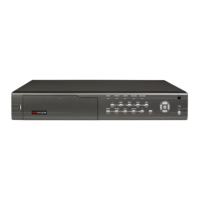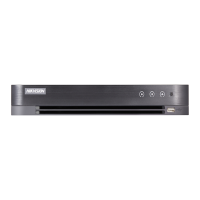DS-7700NI-SP/9000/9600 Series HDVR/NVR User’s Manual
69
Figure 66 UPnP Settings Menu
2. Check the Enable UPnP checkbox.
3. Select the Mapped Type. There are two types:
Auto: Automatic mapping port 8000, 80, 554, 443.
Manual: Edit the port by click .
4. Click the Apply button to save the settings.
Configuring More Settings
You can configure alarm host and port by selecting the more setting tab, as shown in Figure 67.
Figure 67 More Settings Menu
1. Alarm Host: Send the alarm event or exception message to the alarm host when an alarm is
triggered. The remote alarm host must have the CMS (Client Management System) Software
installed.
Enter the IP address of the remote PC on which the CMS Software is installed in.
Enter the alarm monitoring port in Alarm Host Port, which must be the same as the port
configured in the software.
2. Port:
Server Port: Enter the Server Port which designates the port to be used with the client
software.
HTTP Port: Enter the HTTP Port which refers to the one to be used with the built-in Web
Server.
Multicast IP: Enter the Multicast IP to enable multicast.
RTSP Port: Enter the PTSP Port. PTSP is a network control protocol designed for use in
entertainment and communication systems to control streaming media servers.
HTTPS Port: Check the Enable HTTPS checkbox and enter the HTTPS Port. HTTPS is used
for secure communication over network.
3. More: Enable High-speed Download: Check the Enable High-speed Download checkbox. High-
speed Download is used to enhance the speed of network download, but it may cause local GUI
operation stucked.
4. Click Apply to save the network settings and click to return to the previous menu. Click
without clicking Apply will quit out of the menu without saving settings.
